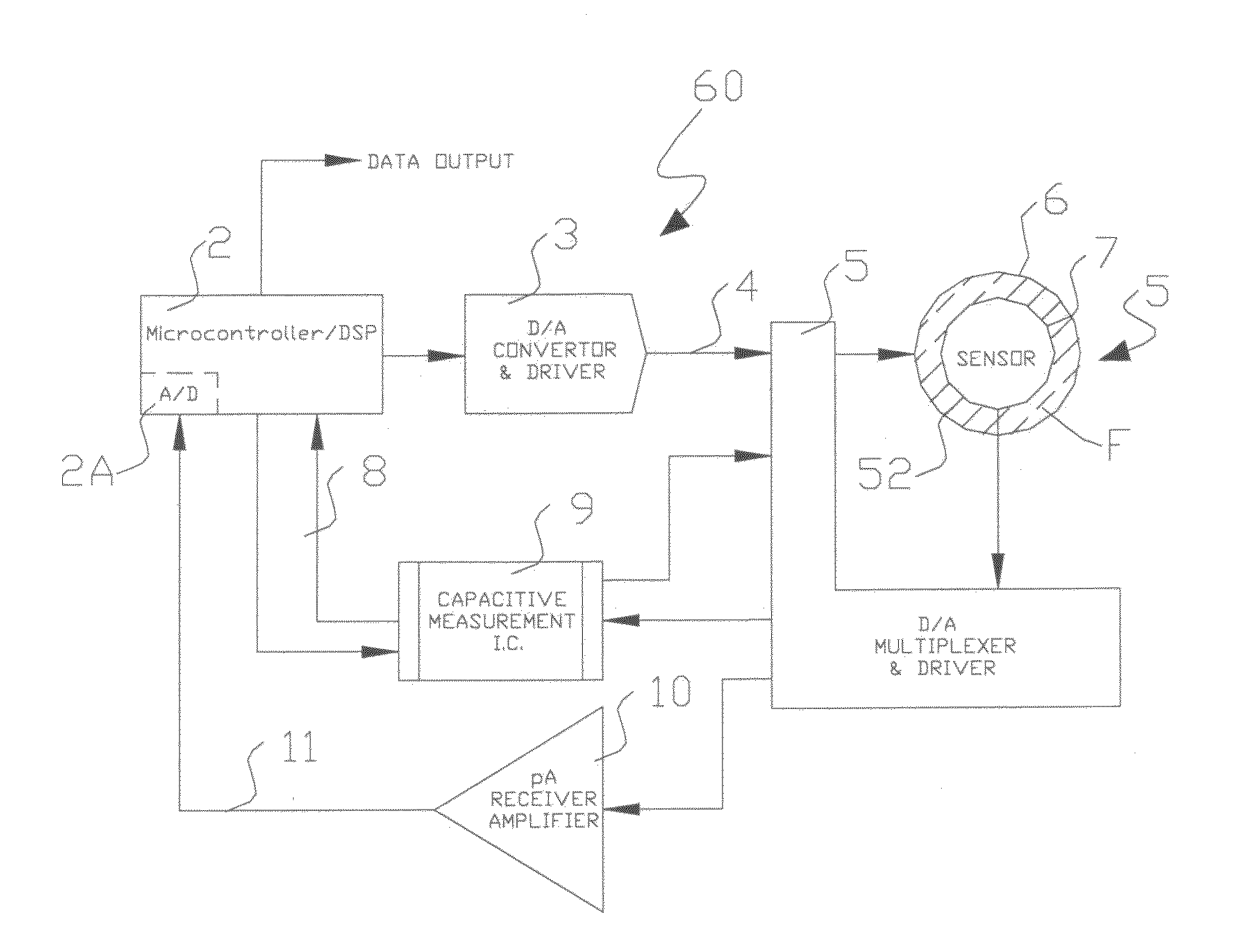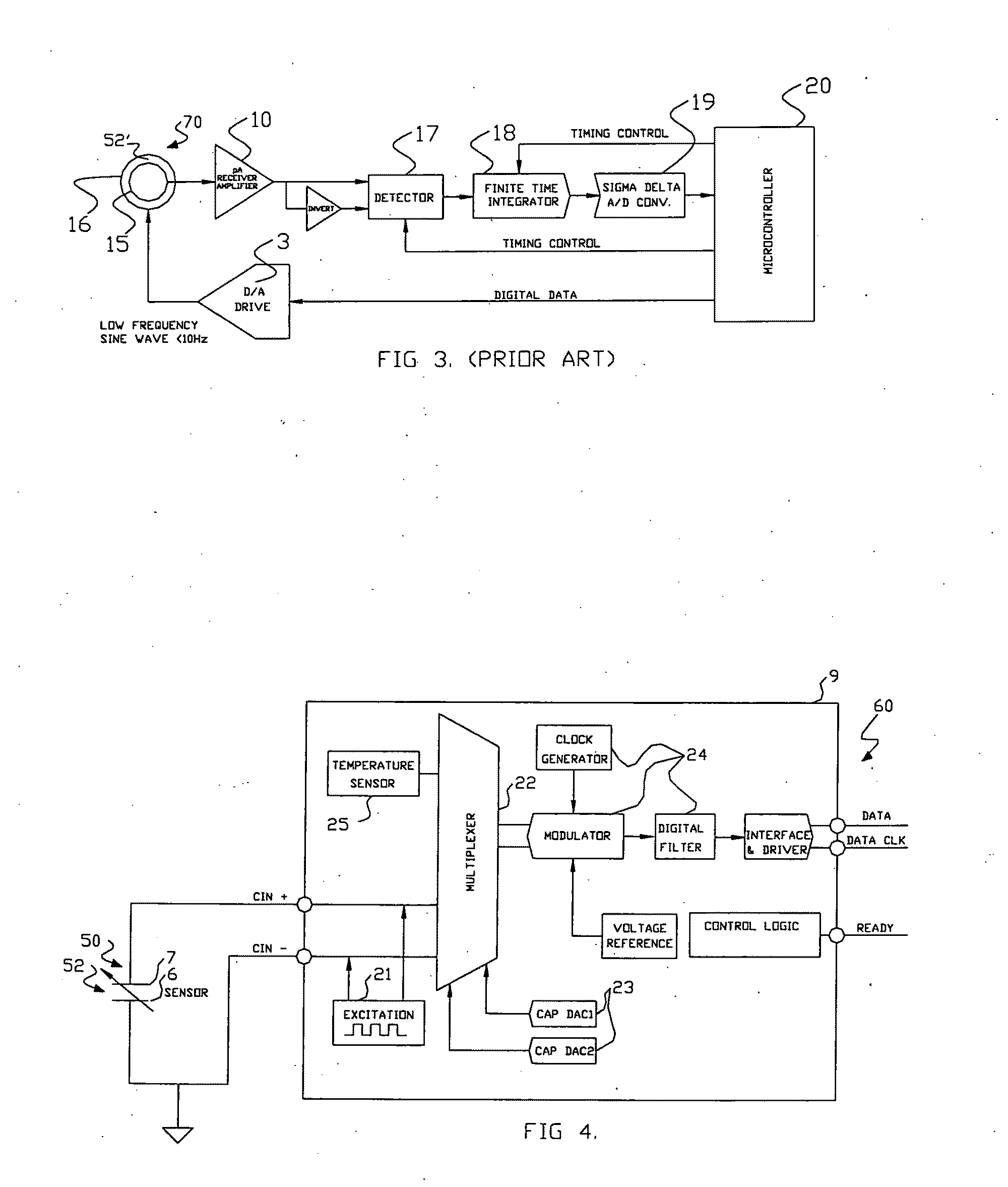[0008]The present invention provides a sensor,
system of measurement, and method of measurement of conductivity and dielectric constant of a fluid, particularly
high impedance, hydrocarbon-based fluids, on a
single pair of coaxial electrodes combined with unique sensor
signal processors. This invention uses mutually compatible sensor geometry for the electrodes, i.e. a geometry that provides both the correct cell constant for conductivity of hydrocarbons fluids (typical range 0-100,000 pS / cm), and a sensor whose bulk capacitance (for use in dielectric constant measurement) in the range of measure of readily available low cost commercial IC's (having a typical capacitance measurement span of <10 pF, with a total bulk capacitance at the
chip of <20 pF). A sensor with a geometry meeting these requirements is then used to form a very low cost system to accurately determine both conductivity and the dielectric constant of the fluid in question.
[0009]The ability to measure both parameters in the same volume of fluid has additional advantages as the measures can be correlated to better determine the “condition” of the hydrocarbon fluid and its ability to remain in service, e.g., lubricating large electrical power and marine diesel engines. The cell conductivity constant for use with hydrocarbon-based oils having a conductivity in the range of 1 to 500,000 pS / M is preferably less than or equal to about 0.1. The cell bulk capacitance of these sensors with hydrocarbon fluids inside results in a bulk capacitance of at least about 4 pF. Additionally, as they are measured on the same volume, they are made at the same temperature. This facilitates the application of thermal corrections to the physical values measured. The electrodes are preferably electrically insulated from a supporting frame by impedances exceeding that of the fluid being measured by several orders of magnitude.
[0010]In one embodiment, electronic circuitry is connected to this same geometry sensor with an
electronic interface connected to a
Microcontroller /
Digital signal Processor (DSP). The
Microcontroller / DSP both generates synchronous drive signals at various frequencies, while directly digitizing and numerically
processing the sensor output. The digitized output is numerically processed in the Microcontroller / DSP into its in-phase and quadrature components from which conductivity and dielectric constant, respectively, are determined. This embodiment results in an even more simplified (lower component count) system. This reduces the required
analog signal processing components, and, the complexity they require. The numerical processing of the signals also reduces processing errors typical of analog circuit processors. The Microcontroller DSP can vary 1) the frequency and amplitude of the sensor drive signals, and 2) the duration over which sample signals are processed (to extend the range or resolution of the
sensor system). These changes can be then made in real time.
[0011]Stated on other words, the Microcontroller has complete control over the process, i.e. it can change the drive frequency to make higher resolution resistive or capacitive measures as needed. If the sensor
signal is larger than expected, it can lower the amplitude, in essence thereby extending the range. On the measurement side the Microcontroller / DSP can use an in-phase and
phase shifted reference (at the same time to make both measures). It can also choose to integrate the
signal over more integer periods of the drive signal period. This reduces the bandwidth of the system, which in turn reduces
noise and improves resolution, at the expense of overall sampling. With this much processing run by the Microcontroller / DSP, the sensor can “adapt” in real time to changing physical conditions in the fluid, or, to modify the
data quality or quantity that the user may need.
[0012]Traditionally capacitance measures are made on dielectrically
coated electrodes. This, of course, does not allow the measurement of electrical conductivity, as no current could flow. As the frequency of operation of the system is under Microcontroller / DSP
program control, real time altering of the
base frequency of operation eliminates the effects of the non
coated electrodes, and or to extend the range resolution of the measures. As a result the present invention uses
metal electrodes exposed (exposed meaning
bare metal or equivalent electrically at least at their opposed, electrically-active surfaces) for both conductivity and dielectric constant measures.
[0014]The invention includes a system and method of operation using the
single pair, preferably coaxial,
electrode sensor. The system, or device, includes low cost integrated circuits for measuring the conductivity and dielectric constant of a high impedance fluid exposed to the sensor as well as a
solid state interface between the sensor and these circuits. The interface bridges differences in the operating electrical parameters of these components, and either automatically switches between the operation of these circuits to produce measurements of conductivity and dielectric constant using only one sensor, or in the second method alters the drive signal and computation path to determine the components. The AC driving signals produced by these circuits are at low frequencies. The combination of a sensor according to the present invention (a single pair of coaxial, exposed
metal electrodes defining a cell having the electrical characteristics noted above, and the aforementioned signal processor provides many of the advantages of the invention. In the form of the invention using a Microcontroller /
DSP processor to control both drive signals to the sensor, and providing subsequent direct
digital conversion with numerical processing of the received sensor signal, results in a sensor electronic system which is especially simple, has low component requirements, and nevertheless meets the resolution requirements for fluid conditioning monitoring.
 Login to View More
Login to View More  Login to View More
Login to View More 


